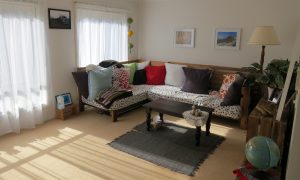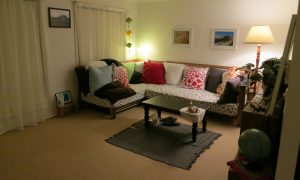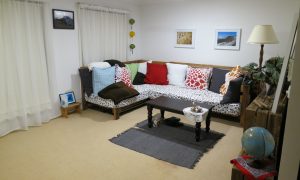| Average Australian home | $237 a year / 2.3kWh a day / 500kg C02 per year |
|---|---|
| Smart renter | $52 a year / 0.5kWh a day / 100kg C02 per year |
| Very smart renter | $10 a year / 0.1kWh a day / 20kg C02 per year |
The easiest and cheapest way to have good lighting in a low energy household is to combine LED technology with smart lighting ideas. You’ll save time, money and have lighting that is much kinder on the body’s circadian rhythms, thus resulting in better sleep.
Prioritise natural light
- In terms of colour and intensity, there’s no substitute for natural light.
- Put couches and desks near windows to take advantage of daylight.
- It also makes more sense to do some tasks during the day when better quality light is available.

Use lighting that works with your body’s circadian rhythms
- Go for stronger white light during the daylight hours (including daylight itself) and weaker warm light during the evening and night.
- Typical lighting values for warm light are 1500-2700K while daylight type light is usually beyond 3000K. These values can be found on the side of the packaging for LED and CFC light bulbs.
Ambient and task lighting
- Use ambient lighting to light a room enough to see the objects in a room and use task lighting close to a task you’re completing instead of trying to light up a whole room with bright lighting.
- The best ambient lights are ceiling mounted fixtures or floor standing lamps that shine light below and bounce light onto a white ceiling to spread light evenly.
- A 10 watt LED bulb can easily provide ambient light for a 20 square metre room whilst a 5 watt LED task light (such as a desk lamp or reading light) will provide adequate task lighting.
- Turn off lights when they are not being used.

Adopt the best lighting technology
- For a renter, good light bulbs are an investment; you can take them with you when you leave.
- LED bulbs are the most cost effective over their lifetime; they are the most energy efficient, are rated for 25,000 hours, handle frequent on/off cycling well and light up instantly.
- If you have leftover CFC bulbs, use them up in places that avoid frequent on/off cycling as these bulbs are almost as energy efficient as LED bulbs and can last up to 15,000 hours.
- Avoid incandescent bulbs. They may be cheaper to purchase but you’ll spend $350 worth of extra electricity and use 25 light bulbs compared to a single LED bulb over its useable lifespan.
- If you need to use up old incandescent bulbs, put them in infrequently used areas.
Avoid using downlights and heat lamps

- If your downlight/s emit a significant amount of heat like an incandescent bulb, then they are halogen downlights. These consume a lot of power.
- LED downlights are a bit better but can still consume a fair bit of power because there are so many of them.
- If you have downlights anywhere in your rental, better to use the normal ceiling lamp (if still installed) or use a table or floor lamp instead.
- Heat lamps can be found in bathrooms and have two to four high powered lamps with a normal light bulb in the centre. When used often, they can knock off a lot of energy.
- Avoid using heat lamps unless you’re getting out of the shower in a really cold bathroom; for all other times, use the normal light instead.
See Solar and battery lighting for cosy and comfortable lighting for on a tiny fraction of what is normally needed (0.1kWh a day or less).